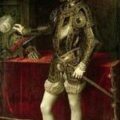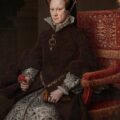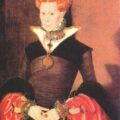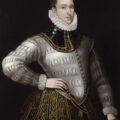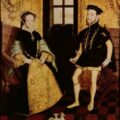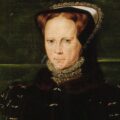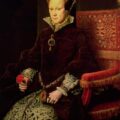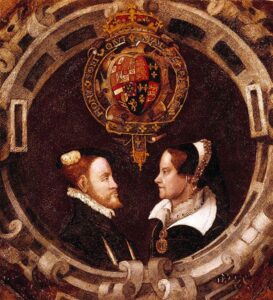
The Wedding
The couple married on a rainy day in Winchester Cathedral, the bishopric of Stephen Gardiner, Mary’s chancellor. Gardiner performed the ceremony, which was a public spectacle and state occasion. Drawing on Spanish, English and Italian sources, Linda Porter gives an excellent rundown of the wedding in Chapter 10 of her book, “Mary Tudor: The First Queen”. She writes of how the 27 year old Philip was first to arrive at the cathedral, arriving at 10am and quotes “The Chronicle of Queen Jane and of the first two years of Queen Mary” regarding his appearance:-
“His breeches and doublet were white, the collar of the doublet exceeding rich, and over all a mantle or rich cloth of gold, a present from the queen… this robe was ornamented with pearls and precious stones; and wearing the collar of the Garter.”1
Interestingly, he and Mary were dressed in the French style (Philip must have loved that) because it was the French style that was fashionable in England at the time.
Who knows what Philip was thinking as he waited for his bride to arrive. Porter quotes Ruy Gomez, one of Philip’s main advisers, describing Philip’s distaste at the idea of marrying the English queen to a colleague in Brussels a few days after the marriage:-
“to speak frankly with you, it will take a great God to drink this cup [but]… the king realises that the marriage was concluded for no fleshly consideration, but in order to remedy the disorder of this kingdom and to preserve the Low Countries.”2
Philip obviously saw himself as a martyr to politics! Mary, however, was smitten by her beau and was full of hope for the future, how sad.
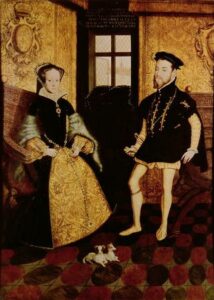
Gardiner began the ceremony by making a speech regarding the marriage treaty and then announced that Charles V had settled the kingdom of Naples on his son, the groom. He then went on to the marriage ceremony itself, pronouncing it in both English and Latin. The Marquess of Winchester and the Earls of Derby, Bedford and Pembroke gave Mary away, on behalf of England and then Mary’s ring, “a plain hoop of gold without any stone in it”4 chosen by the bride because it was traditional, was laid upon the Bible along with the customary three handfuls of gold from both bride and groom, “and when they had enclosed their hands, immediately the sword was advanced before the king, by the earl of Pembroke.” As trumpets sounded, the newly married couple returned to their places to hear mass.
After the marriage ceremony and mass were completed, heralds announced the titles of the Mary and her new husband:-
“Philip and Mary, by the grace of God king and queen of England, France, Naples, Jerusalem and Ireland, defenders of the faith, princes of Spain and Sicily, archdukes of Austria, dukes of Milan, Burgundy and Brabant, counts of Habsburg, Flanders and Tyrol.”5
England now had a king but it was yet to be seen whether this king would also be a ruler of England.
After the wedding, Mary and Philip had a wedding reception at Gardiner’s palace, a sumptuous meal followed by dancing, something that the English members of the wedding party excelled in. The night was still young when the newly married couple departed, ate supper separately and then met for the blessing of their bed, by Gardiner, and the act of consummation.
Wedded Bliss
Although Philip’s adviser, Gomez, had spoken of Philip’s distaste for the idea of marrying Mary, Linda Porter writes of how, in the early days, “Philip could not be faulted”6, and that the Spanish gentlemen at court wrote that “their majesties are the happiest couple in the world, and more in love than words can say. His highness never leaves her, and when they are on the road he is ever by her side, helping her to mount and dismount”7. Mary wrote to Charles V of her happiness and thanking him, saying:-
“I will only offer to your majesty all that my small powers enable me to give, always praying God so as to inspire my subjects that they may realise the affection you bear this kingdom and the honour and advantages you have conferred upon it by this marriage and alliance, which renders me happier than I can say, as I daily discover in the king, my husband and your son, so many virtues and perfections that I constantly pray God to grant me grace to please him and behave in all things as befits one who is so deeply embounden to him…”8
Gomez wrote too of the happy couple:-
“He treats the queen very kindly and well knows how to pass over the fact that she is no good from the point of view of fleshly sensuality. He makes her so happy that the other day when they were alone she almost talked love-talk to him, and he replied in the same vein.”9
Mary was clearly in love and Philip knew that he had to do his job. It was a hopeful start to the royal marriage.
Good News and Bad News
On the 18th September, just under 2 months after the wedding, Simon Renard, the Imperial ambassador, announced that Mary believed that she was pregnant and on the 2nd October Ruy Gomez reported that Mary was definitely with child. At the end of November, Mary felt her baby move and there was public rejoicing over this good news. In mid April Mary withdrew from court for her lying-in at Hampton Court Palace but by the end of May there was still no sign of the expected prince or princess. On the 4th August, Mary finally left Hampton Court Palace, facing up to the truth that her baby did not exist.. It is likely that she had suffered from a phantom pregnancy.
A Queen Abandoned
Contrary to popular belief, Philip did not leave his bride straight after the wedding, he remained in England until the following August. On the 29th August 1555, after it was clear that Mary was not going to give birth to his child, Philip left England for the Low Countries but only because he was desperately needed there and had to do his duty. Mary was left childless and husbandless and had to deal with trouble and plots against her by herself.
On the 20th March 1557, 19 months after his departure, Philip was reunited with Mary at Greenwich. The reason for his return was to raise English troops to help him go to war against France and when he had completed this mission in July 1557 he abandoned his wife again. Again, Mary believed that she was pregnant, but when no baby had arrived by Spring 1558 Mary had to drop the pretence – poor Mary. Mary was made even more unhappy by a quarrel with her husband over Philip’s idea of marrying her half-sister, Elizabeth, off to the Duke of Savoy. Mary resisted the idea and Philip was not happy.
The End
On the 17th November 1558 the 42 year old Mary I died after a few months of illness. Her husband, Philip, had been to busy abroad, dealing with he aftermath of his father’s death, to return to England. Upon Mary’s death, Philip lost his title of King of England and Ireland and had no claim to the English throne. On hearing of the death of his wife, Philip told his sister Juana: “I felt a reasonable regret for her death. I shall miss her.”1o Always the politician, Philip went on to send a proposal of marriage to the new queen, Elizabeth I, Mary’s half-sister but this was not meant to be.
Notes and Sources
- Mary Tudor: The First Queen, Linda Porter, p322
- Ibid., p320
- Ibid., p323
- Ibid.
- Ibid., p324
- Ibid., p326
- Ibid., p327
- Ibid.
- Ibid.
- Ibid., p407

